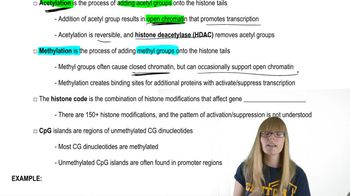In this chapter, we focused on how eukaryotic gene expression is regulated posttranscriptionally. At the same time, we found many opportunities to consider the methods and reasoning by which much of this information was acquired. From the explanations given in the chapter:
How do we know that microRNAs negatively regulate target mRNAs?
Table of contents
- 1. Introduction to Genetics51m
- 2. Mendel's Laws of Inheritance3h 37m
- 3. Extensions to Mendelian Inheritance2h 41m
- 4. Genetic Mapping and Linkage2h 28m
- 5. Genetics of Bacteria and Viruses1h 21m
- 6. Chromosomal Variation1h 48m
- 7. DNA and Chromosome Structure56m
- 8. DNA Replication1h 10m
- 9. Mitosis and Meiosis1h 34m
- 10. Transcription1h 0m
- 11. Translation58m
- 12. Gene Regulation in Prokaryotes1h 19m
- 13. Gene Regulation in Eukaryotes44m
- 14. Genetic Control of Development44m
- 15. Genomes and Genomics1h 50m
- 16. Transposable Elements47m
- 17. Mutation, Repair, and Recombination1h 6m
- 18. Molecular Genetic Tools19m
- 19. Cancer Genetics29m
- 20. Quantitative Genetics1h 26m
- 21. Population Genetics50m
- 22. Evolutionary Genetics29m
13. Gene Regulation in Eukaryotes
Epigenetics, Chromatin Modifications, and Regulation
Problem 4
Textbook Question
What general role does acetylation of histone protein amino acids play in the transcription of eukaryotic genes?
 Verified step by step guidance
Verified step by step guidance1
Understand that histones are proteins around which DNA is wrapped in eukaryotic cells, forming a structure called chromatin. This packaging can regulate gene expression by controlling the accessibility of DNA to transcription machinery.
Recognize that acetylation is a chemical modification where an acetyl group (CH₃CO) is added to the amino acid residues of histone proteins, typically lysine residues in the histone tails.
Learn that acetylation of histones neutralizes the positive charge on lysine residues, reducing the interaction between histones and the negatively charged DNA. This loosens the chromatin structure, making it more open.
Understand that the open chromatin structure allows transcription factors and RNA polymerase to access the DNA more easily, thereby promoting the transcription of genes.
Conclude that histone acetylation generally plays a role in activating gene expression by increasing the accessibility of DNA to the transcriptional machinery.
 Verified video answer for a similar problem:
Verified video answer for a similar problem:This video solution was recommended by our tutors as helpful for the problem above
Video duration:
3mPlay a video:
Was this helpful?
Key Concepts
Here are the essential concepts you must grasp in order to answer the question correctly.
Histone Acetylation
Histone acetylation is a post-translational modification where acetyl groups are added to the amino acids of histone proteins. This modification reduces the positive charge on histones, leading to a more relaxed chromatin structure. As a result, the DNA becomes more accessible for transcription factors and RNA polymerase, facilitating gene expression.
Recommended video:
Guided course

Histone Protein Modifications
Chromatin Structure
Chromatin is the complex of DNA and proteins that forms chromosomes within the nucleus of eukaryotic cells. It exists in two forms: euchromatin, which is loosely packed and transcriptionally active, and heterochromatin, which is tightly packed and transcriptionally inactive. The acetylation of histones promotes the transition from heterochromatin to euchromatin, thereby enhancing transcription.
Recommended video:
Guided course

Chromatin
Transcription Regulation
Transcription regulation refers to the mechanisms that control the rate and timing of gene expression. Acetylation of histones is a key regulatory mechanism that influences transcription by altering chromatin structure. This modification works in conjunction with other factors, such as transcription factors and co-activators, to initiate and enhance the transcription of specific genes.
Recommended video:
Guided course

Eukaryotic Transcription
Related Videos
Related Practice
Textbook Question
481
views


